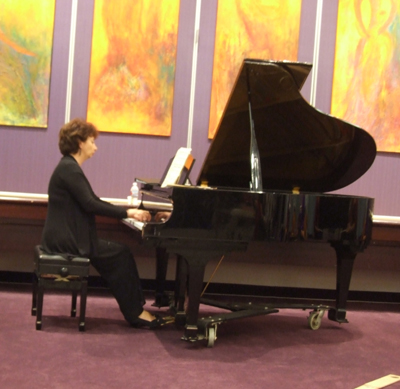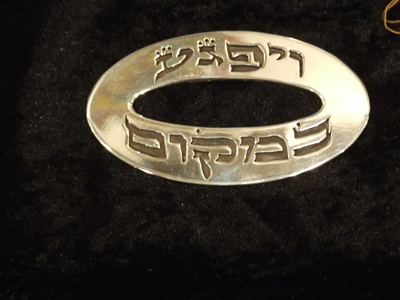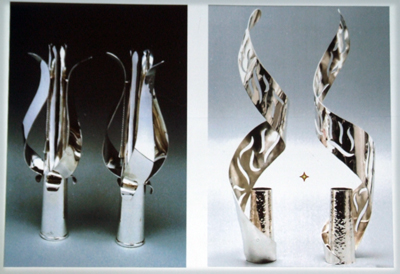|
By Donald H. Harrison
 SAN DIEGO—What do these have in common? A Havdalah service. A performance by a piano quintet – that is, a string quartet joined by a pianist. An exhibition of the works of an American-born silversmith now living and working in Raanana, Israel. The prayers of Conservative Jews in a late evening Selichot service. SAN DIEGO—What do these have in common? A Havdalah service. A performance by a piano quintet – that is, a string quartet joined by a pianist. An exhibition of the works of an American-born silversmith now living and working in Raanana, Israel. The prayers of Conservative Jews in a late evening Selichot service.
These all occurred Saturday night, September 12, at Tifereth Israel Synagogue. They could be viewed as four successive and unique components in an evening of spiritual preparation for the High Holy Days. Or, they might be considered elements in a tapestry of Jewish interrelationships.
The setting for most of the evening was the Cohen Social Hall, familiar to many concert goers as the performance space for the Tifereth Israel Community Orchestra (TICO) led by conductor David Amos. But whereas the community orchestra sets up on the northern side of the rectangular hall; on this evening, the direction of the portable chairs was reversed, so that pianist Irina Bendetsky and Miryam String Quartet members Eileen Wingard, Myla Wingard, Dorothy Zeavin and Marcia Bookstein performed from the room’s southern end, in front of an elevated stage.

Six acrylic paintings on stretched canvas of dancing figures dominated the panels of a stage-to-ceiling folding wall that served as the piano quintet’s backdrop. Particularly as Bendestsky played the livelier portions of Felix Mendelssohn’s Rondo Capriccioso for Piano, Opus 14, and as the entire ensemble performed a closing Freilach arranged by Eileen Wingard, it seemed as if the large figures painted by San Diego artist Jacqueline Jacobs were whirling and jumping to the music. The middle four paintings bear a Hebrew legend, which when translated by Rabbi Leonard Rosenthal, the congregation’s spiritual leader, is rendered as “Praise be God who creates joy in our midst.”
Eileen Wingard, violinist, served as narrator for the group which also includes her daughter, Myla Wingard, (violin), Marcia Bookstein (cello) and Dorothy Zeavin (viola). As Eileen writes a column occasionally for San Diego Jewish World and this publication is continuing to present in audio-and-print format the songs of her late husband, Hal Wingard, my wife Nancy and I especially felt the presence of the Wingard family in the room.
A long table on the eastern wall, where refreshments were set out, also is used by the congregation’s Friendship Club, a group of mainly elderly congregants who gather periodically for lunch, lectures and companionship. For many years, Eileen’s late mother, Rose Schiff, was a member of that club, serving for a stretch as its president. Seated in the audience were Myla’s husband, Dr. Lou Rosen, and their daughter—Eileen’s granddaughter—Adira. Earlier in the evening, Rabbi Rosenthal had honored Adira by choosing her to hold the Havdalah candle during a brief service marking the end of Shabbat. The light emanating from the Cohen Social Hall’s two large Magen-David shaped chandeliers had been darkened to heighten the effect of the candle’s flame.
Like her mother, Myla Wingard had been a music major on a University of California campus. Eileen studied at UCLA; Myla at UCSD. Eileen continued at UCLA for her master's degree, then with a Fulbrigfht Scholarship studied music in Stuttgart, Germany. After UCSD, Myla went to Harvard Divinity School, where she earned a master’s degree in Hebrew Bible while continuing her music studies. One of her teaching assistants had been Yo-Yo Ma, the internationally acclaimed cellist.
Eileen Wingard had been a colleague with Bookstein and Zeavin in the San Diego Symphony, and between Zeavin and Bookstein is another familial relationship: they are sisters. So the quartet has a mother and daughter, and two sisters, and the pieces they and pianist Bendetsky played at times merged in a single voice—as families can do—and at other times were contrapuntal and polyphonic. What family does not also experience this pleasant phenomenon?
The program opened with two quick High Holy Day melodies (a version of the “Hatzi Kaddish” and “Avinu Malkenu”) arranged by Eileen Wingard. Zeavin’s and Bendetsky’s talents next were showcased in Ernest Bloch’s Rhapsody from Suite Hebraique for Viola & Piano. An immigrant from the former Soviet Union where she studied at the Gnessen Conservatory of Music, Bendetsky today is a member of the University of San Diego’s music faculty, and also teaches privately. Zeavin, besides playing for the San Diego Symphony, serves as principal viola of the San Diego Opera Orchestra. Every summer, she heads north to play with Oregon Bach Festival.
The three musicians who had been San Diego Symphony colleagues had special feelings of association with the next pieces played— “Ponar” by Alec Volkoviski and “Es Brent” by Mordekhai Gebirtig—in an arrangement for string quartet by Yoav Talmi. Winner of the 2008 Israel Prize, Talmi earlier in his career had been the conductor—their conductor—of the San Diego Symphony, and Bookstein had been a featured performer, along with the conductor’s wife and flutist, Er’ella Talmi, on the album Talmis play Talmi.
“Ponar” is a composition about the forest near Vilnius, Lithuania, where Nazis slaughtered Jews—“The Babi Yar of Lithuania,” as Eileen Wingard put it. “Es Brent” is a Yiddish folksong exhorting Jews to do something to avert the burning of their town. Later in the program, two other Holocaust- era melodies were dedicated to a member of the audience — nonagenarian Eve Gerstle, originally of Wiesbaden, Germany, who survived Terezin, the Nazi’s showcase ghetto community. “Uv’tzeil K’nofecho (In the Shadow Of Your Wings)” by Gruenfeld-Zikmund Schul, and “Lied Ohne Worte (Song Without Words)” by Frantisek Domazlicky both were composed by Gerstle’s fellow prisoners in the ghetto/ concentration camp.
Another Bloch piece, “Meditation Hebraique for Cello & Piano” gave the audience an opportunity to hear Bookstein, whose
Go to the top of next column
| — |
teachers included the celebrated Gregor Piatigorsky and who once had served as principal cellist of the Jerusalem Orchestra.
Most of the evening’s works were by Jewish composers—or in the case of Mendelssohn, a composer who had been Jewish. Grandson of the great Jewish scholar, Moses Mendelssohn, Felix was converted to Christianity at age 7 at the insistence of his father, Abraham, who believed assimilation necessary for the young prodigy to achieve continued success in his music career.
But why did Wingard also include the first movement Johannes Brahms “Piano Quintet in F minor, Opus 34” in the program? No, Brahms was not Jewish, Wingard told the audience. The music was included because, first, it is beautiful, and second, because Brahms did have Jewish connections. His mentor and a great musical influence was Joseph Joachim, a Jew, who in turn had been a protégé of Mendelssohn.
Saturday evening’s concert had attracted approximately 70 people, including some music lovers from other congregations. Among these were Emily Jennewein, president-elect of Congregation Beth Israel, and her husband Chris, the chief executive officer of San Diego News Network. Beth Israel is the only congregation in San Diego that is older than Tifereth Israel. The Reform congregation is soon to celebrate its 150th anniversary, whereas Tifereth Israel will observe its 104th anniversary these coming High Holy Days.
Rabbi Rosenthal summoned the noshers back from their repasts of crackers, cheeses, fruit and cookies to hear a presentation by silversmith Rachel Rowen, who was born in Cleveland, Ohio, and who later lived in Chappaqua, New York (“before the Clintons”), where she first began creating in silver. A graduate of Yale University, where she met husband Louis, the couple moved to Israel, where he is today a professor of mathematics at Bar Ilan University and an amateur cellist.
Rachel Rowen said her career was greatly influenced by a Yemenite Jewish silversmith, Shalom Tubi, and that in her work, especially her Judaica, she sometimes combines the intricate filigree so distinctive in Yemenite silver with more modern elements, to create works that are simultaneously traditional and contemporary.

One item that intrigued many members of the congregation was a simple silver oval that can be placed by a reader over several words of a Torah to show the next reader exactly where to begin the next passage.
Rowen also designs rimonim—the ornaments that one places atop the handles of a Torah scroll. Rabbi Rosenthal, on a trip to Israel for a rabbinical conference, had purchased two sets of rimonim that Rowen had displayed at the conference—and that is how Rowen’s connection to the congregation was formed.

One set of rimonim, reminiscent of flames, sits atop Tifereth Israel’s Holocaust Torah—looted by the Nazis from a Czech congregation and later placed back into the service of the Jewish people. The mantle covering that Torah shows butterflies freeing themselves from barbed wire, in an allusion to the poem “I Never Saw Another Butterfly” by young Terezin inmate Pavel Friedmann, who was killed in the Holocaust. The designer of that mantle was Jacqueline Jacobs, whose large paintings earlier in the evening had provided the backdrop for the concert. The other set of rimonim are used on a Torah that is read every week by the congregation.
Although Rowen made some sales on Saturday evening, the time was short before formal Selichot services began. Her works can be seen and purchased on line at rowen@netvision.net.il.
For the formal Selichot services, the group, which by now had dwindled to approximately 40, moved into the sanctuary that is dominated by a Holy Ark set amid stained glass windows depicting the Burning Bush. Rabbi Rosenthal led readings in English and Hebrew from the lectern on the right side of the bima.
In this service, too, were interwoven themes: the sorrow over any spiritual misdeeds or broken commandments that congregants may have committed, coupled with the expectations, and excitement, that God will forgive them, provided their repentance is sincere.
Some of the prayers in the Selichot service might be considered previews of coming attractions. There is the “Avinu Malkenu (Our Father, Our King)” prayer, which had been part of the concert, and the “Ashamnu (We Abuse)” prayer, by which congregants, many tapping their heart for emphasis, admit their transgressions over the past year.
I particularly enjoyed an English reading, “The Lord Will Accept My Prayer,” in which congregants seek to ingratiate themselves to the Lord as they beg forgiveness.
It reads, in part:
Return to me, Lord, and rescue me;
Save me, for the sake of Your kindness.
In death there is no one to remember You.
In the grave who can praise You?
Here, too, then, is a fascinating interrelationship.
We Jews need God. But maybe, just maybe, God needs us too?
|
|

